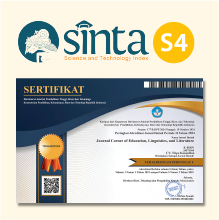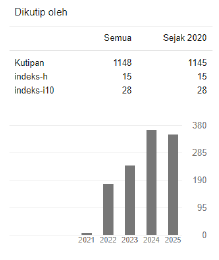Indonesian Language Acquisition of 0-2-Year-Old Children: A Study of Psycholinguistic Perspective
 https://doi.org/10.54012/jcell.v3i3.274
https://doi.org/10.54012/jcell.v3i3.274
 Abstract views: 905
Abstract views: 905
 PDF downloads: 636
PDF downloads: 636
Keywords:
psycholinguistics, early childhood, language acquisition, communication, languageAbstract
This study discusses the problem of phonology and morphology acquisition in children aged 0-2 years whose parents use Indonesian in their daily interaction (communication) in the family while the surrounding community interacts (communicates) using the local language (Javanese). This research concludes that the embryonic development of children's language can vary in each individual, can develop quickly and can also be slow, depending on the level or level of age, the ability of the parents, and the active environment to develop it. This type of research is descriptive qualitative research. The data generated from this research is in the form of spoken words, which will then be transcribed into writing. Data related to this research, which is devoted to language acquisition in the form of phonology and morphology acquisition in children aged 0-2 years, was obtained using several methods.
Downloads
References
Agnew, S. E., Powell, M. B., & Snow, P. C. (2006). An examination of the questioning styles of police officers and caregivers when interviewing children with intellectual disabilities. Legal and Criminological Psychology, 11(1), 35–53. https://doi.org/10.1348/135532505X68494
Alderson, J. C. (2000). Assessing Reading. Assessing Reading. https://doi.org/10.1017/cbo9780511732935
Anggraini, Nofita. (2019). Kesantunan Berbahasa Anak Dalam Perspektif Pemerolehan Bahasa Dan Peran Serta Pendidikan Karakter. Seminar Bahasa dan Sastra Indonesia Universitas Sriwijaya. Volume 2, Nomor 1, pp 68-78.
Apriliana, Gita., Sukma, Irwan., Aryana, Mita., & Maharani, Nurul. (2024). Pengaruh Pemerolehan Bahasa Pertama dan Kedua Anak Terhadap Kesalahan Berbahasa Tingkat Fonologi. Jurnal Review Pendidikan dan Pengajaran. Volume 7, Nomor 1, pp 609-616.
Apriyanto, S., & Anum, A. (2018). Gender Dynamics on Speaking Interaction in the College Classroom. Jurnal Smart, 4(2), 73. https://doi.org/10.26638/js.692.203x
Apriyanto, S., & Nurhayaty, A. (2019). Born In Social Media Culture: Personality Features Impact In Communication Context. In Y. Nasucha (Ed.), icollit (pp. 167–175). UMS Press. icollit.ums.ac.id/2018
Ayu, I., Erlina, H., Santoso, D., & Apriyanto, S. (2020). Perspective of Parents of Online Learning in Pandemic Covid-19. Journal of Research in Business, Economics, and Education, 2(6), 1346–1350.
Chaer, Abdul. (2018). Sintaksis Bahasa Indonesia. Jakarta: PT. Rineka Cipta.
CJ, J. (2018). Improving the Students Speaking Ability Through Role Play Method. IJET (Indonesian Journal of English Teaching), 7(1), 87–97. https://doi.org/10.15642/ijet2.2018.7.1.87-97
Cleary, H. M. D. (2010). AN OBSERVATIONAL STUDY OF INTERVIEW CHARACTERISTICS AND MIRANDA IN JUVENILE INTERROGATIONS. Georgetown University.
Dardjowidjojo, Soenjono, (2014). Psikolinguistik Pengantar Pemahaman Bahasa Manusia, Jakarta: Pustaka Obor Indonesia.
Elek, B. (2016). To the Recommendation of Using “Linguistic Fingerprints” in the Criminal Procedure“. Comparative Legilinguistics, 28, 134. https://doi.org/http://dx.doi.org/10.14746/cl.2016.28.6.
Endarweni, Y. (2014). Implementing the Show and Tell Technique to Improve the Speaking Skill of Grade VIII Students at Smp Pembaharuan Purworejo [Universitas Negeri Yogyakarta]. https://pdfs.semanticscholar.org/19fa/171789f7
Fomin, A. G., & Yakimova, N. S. (2016). Communication Strategies in Conflict Discourse: Cross-cultural Experimental Research. Procedia - Social and Behavioral Sciences, 236(December 2015), 65–70. https://doi.org/10.1016/j.sbspro.2016.12.021
Gani, S. A. (2017). Parenting Digital Natives: Cognitive, Emotional, and Social Developmental Challenges. International Conference on Education, 870–880. http://pasca.um.ac.id/conferences/index.php/ice/article/view/118
Gottschalk, F. (2019). Impacts of technology use on children: Exploring literature on the brain, cognition and well-being. OECD Education Working Papers, 26(3), 313–316. https://doi.org/10.1089/cap.2015.0029
Hasbullah, M. (2020). Hubungan Bahasa, Semiotika dan Pikiran dalam Berkomunikasi. AL-IRFAN. Volume 3, Nomor 1, pp 106-124.
Herman, M., Mulya, C., & Apriyanto, S. (2021). The Implementation of Education Financing Through Bos Fund Management in Improving. Jurnal Inspiratif Pendidikan, X(1), 90–101.
Kotorova, E. G. (2014). Describing Cross-cultural Speech Behavior: A Communicative-pragmatic Field Approach. Procedia - Social and Behavioral Sciences, 154(October), 184–192. https://doi.org/10.1016/j.sbspro.2014.10.133
Leuprecht, C., & Skillicorn, D. B. (2016). Incumbency effects in U.S. presidential campaigns: Language patterns matter. Electoral Studies, 43, 95–103. https://doi.org/10.1016/j.electstud.2016.05.008
Mahsun. 2017. Metode Penelitian Bahasa, Tahapan, Strategi, Metode dan Tekniknya.
Mailani, Okarisma., Nuraeni, Irna., Syakila, Sarah Agnia., & Lazuardi, Jundi. (2022). Bahasa Sebagai Alat Komunikasi Dalam Kehidupan Manusia. KAMPRET JOURNAL. Volume 1, Nomor 2, pp 01-10.
Moleong, L.J. (2017). Metode Penelitian Kualitatif. Bandung: PT. Remaja Rosdakarya.
Nagy, W. E., & Anderson, R. C. (1984). How Many Words Are There in Printed School English? Reading Research Quarterly, 19(3), 304. https://doi.org/10.2307/747823
Noermazah. (2019). Bahasa sebagai Alat Komunikasi, Citra Pikiran, dan Kepribadian. Prosiding Seminar Nasional Bulan Bahasa (Semiba). Pp 306-319.
Nur Septiadi, H., Endah Pratiwi, Y., & Rafid, R. (2021). Psychological Value in the Poetry “Bukit Doa” by Irna Novia Darmayanti. Journal Corner of Education, Linguistics, and Literature, 1(1), 8–13. https://doi.org/10.54012/jcell.v1i1.6
Psikolinguistik. LINGUA: Journal of Language, Literature, and Teaching. Volume 15, Nomor 1, pp 45-52.
Suardi, Indah Permatasari., Ramadhan, Syahrul., Asri, Yasnur. (2019). JURNAL OBSESI: Jurnal Pendidikan Anak Usia Dini. Volume 3, Nomor 1, pp 265-273.
Sundari, Weli. (2018). Pemerolehan Bahasa. Jurnal Warna. Volume 2, Nomor 1, pp 54-75.
Syaprizal, Muhammad Peri. (2019). Proses Pemerolehan Bahasa pada Anak. AL-HIKMAH (Jurnal Pendidikan dan Pendidikan Agama Islam). Volume 1, Nomor 2, pp 75-86.
van Niejenhuis, C., Otten, S., & Flache, A. (2018). Sojourners’ second language learning and integration. The moderating effect of multicultural personality traits. International Journal of Intercultural Relations, 63(June 2017), 68–79. https://doi.org/10.1016/j.ijintrel.2018.01.001
Wesche, M. B. (2012). Content-Based Second Language Instruction. The Oxford Handbook of Applied Linguistics, (2 Ed.), May 2018, 1–22. https://doi.org/10.1093/oxfordhb/9780195384253.013.0019
Yaylacı, Ş., & Beauvais, E. (2017). The Role of Social Group Membership on Classroom Participation. PS: Political Science & Politics, 50(02), 559–564. https://doi.org/10.1017/S104909651600319X
Downloads
Published
How to Cite
Issue
Section
License
Copyright (c) 2024 Adelina Anum, Ratna Susanti, Abd. Syakur

This work is licensed under a Creative Commons Attribution-ShareAlike 4.0 International License.
All articles published in the Journal Corner of Education, Linguistics, and Literature are licensed under the Creative Commons Attribution-ShareAlike License (CC BY-SA).

















